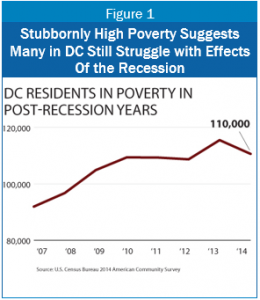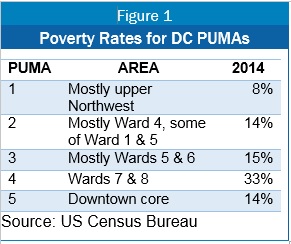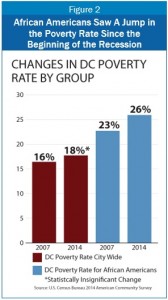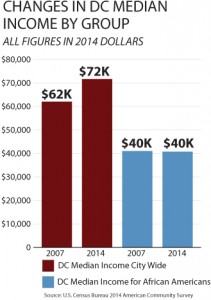The District economy continues to grow, but communities of color are still facing difficult challenges, based on new income a nd poverty data from the U.S. Census Bureau. Some 18,000 more DC residents were poor in 2014 than in 2007, before the last recession, with African Americans being hardest hit. The findings highlight the need for DC to do more to expand opportunity and make it easier for all people in the city to build a secure future.
nd poverty data from the U.S. Census Bureau. Some 18,000 more DC residents were poor in 2014 than in 2007, before the last recession, with African Americans being hardest hit. The findings highlight the need for DC to do more to expand opportunity and make it easier for all people in the city to build a secure future.
On the positive side, the new Census findings also show that comprehensive implementation of the Affordable Care Act led to a drastic decrease in the number of residents without health insurance.
Poverty Remains High Despite Years of Economic Growth
The number of District residents in poverty grew from 92,000 to 110,000 between 2007 and 2014 (See Figure 1.). However, the District’s poverty rate of 18 percent did not increase significantly due to population growth. The growth in the number of people living in poverty, or less $24,000 for a family of four, shows that the District’s recovery is not reaching everyone.
Some 57,000 residents live in deep poverty — or less than $12,000 a year for a family of four. Deep poverty in the District is about the same today as in 2007. Of those experiencing deep poverty, 14,000 are children.
The Census Bureau breaks down the District into five areas that roughly correspond to some ward boundaries, but with significant overlap — known as public use microdata areas or PUMAs. This year’s picture of the geographic distribution of poverty is largely consistent with last year’s and with pre-recession times. The area corresponding to Wards 7 and 8 continues to have the highest poverty rate in the city — 33 percent, compared to 18 percent citywide (See Table 1). There was one statistically significant change in 2014: poverty in Northeast (PUMA 3) fell slightly, from 16 percent in 2013 to 15 percent in 2014.
African-American DC Residents Are Still Struggling with the Effects of the Recession
Last year, more than one in four African Americans in the District made so little that they were considered poor. Only 7 percent of non- Hispanic whites found themselves in this situation in 2014. What’s more, African Americans are the only racial or ethnic group to see an increase in the poverty rate since 2007 — now 26 percent (See Figure 2). The median income for African American DC households was stagnant between 2007 and 2014, when adjusted for inflation, at about $41,000. Yet, the median income for all DC households rose by nearly $10,000 to $71,648 (See Figure 3).
Hispanic whites found themselves in this situation in 2014. What’s more, African Americans are the only racial or ethnic group to see an increase in the poverty rate since 2007 — now 26 percent (See Figure 2). The median income for African American DC households was stagnant between 2007 and 2014, when adjusted for inflation, at about $41,000. Yet, the median income for all DC households rose by nearly $10,000 to $71,648 (See Figure 3).
Skills and educational achievement gaps, as well as fewer well-paying jobs, continue to hit communities of color especially hard. The large difference in poverty rates mirrors the racial disparity in educational attainment. A much smaller share of African Americans have a high school diploma than whites, and a college education remains a distant dream in many communities of color.
- One in seven African Americans, and around one in three Latinos does not have a high school diploma or the equivalent, compared to only one in 30 whites. Only a quarter of African Americans has a bachelor’s degree.
- The poverty rate for people without a high school diploma is 20 percentage points higher than the overall poverty rate — 34 percent compared to 14 percent. People with a high school diploma but no college education fared only slightly better, with 24 percent in poverty.
- At 10 percent, the unemployment rate for African Americans remains five times higher than white unemployment, and twice as high as Latino unemployment rates. The continued economic recovery hasn’t closed this gap, which remains statistically similar to last year’s and to the time before the recession
Improvement in Health Insurance Coverage Shows that Progress in Reducing Disparities Is Possible
DC should take immediate action to make it easier for people to build a secure future. An example of positive efforts to expand opportunity is the District’s assertive implementation of health reform. The data show that the District’s investments in Medicaid expansion and the DC Health Exchange (DC Health Link) reduced the number of uninsured residents from 48,000 to 37,000 between 2013 and 2014 — a drop of almost 20 percent. The gains resulted from more people directly purchasing their insurance or enrolling in Medicaid — both objectives of the DC Health Link. This means that 95 percent of District residents have health insurance, including 98 percent of children. DC now has the second lowest rate of uninsured residents of any state.
Knowing that success, DC should move forward in investments that even the playing field and help our communities succeed. Increasing investments to affordable housing through the Local Rent Supplement Program, expanded access to job training programs, better quality child care, and cash assistance for those facing severe barriers to employment will help residents make ends meet and pursue opportunities to escape poverty.
To print a copy of today’s blog, click here
.
